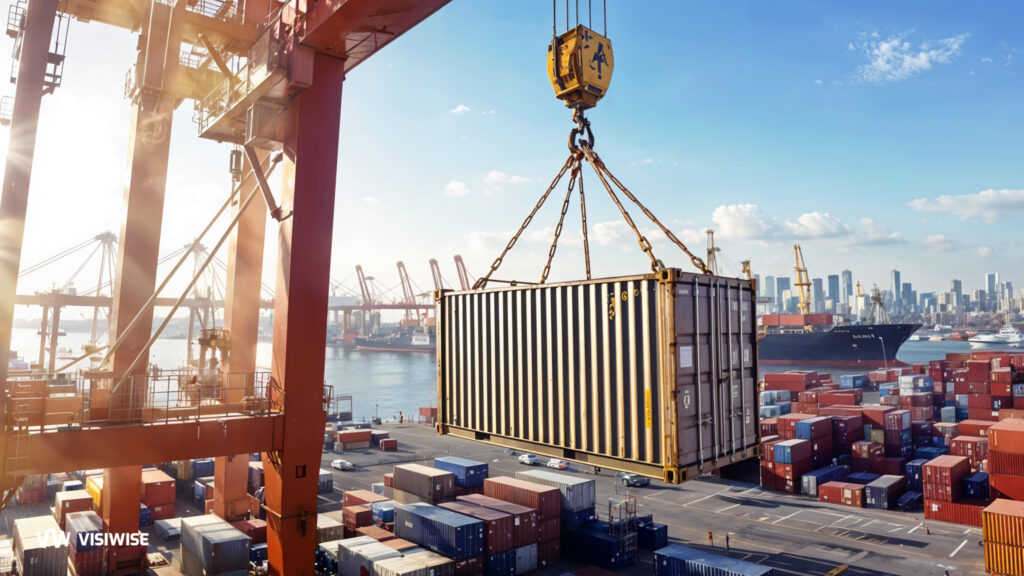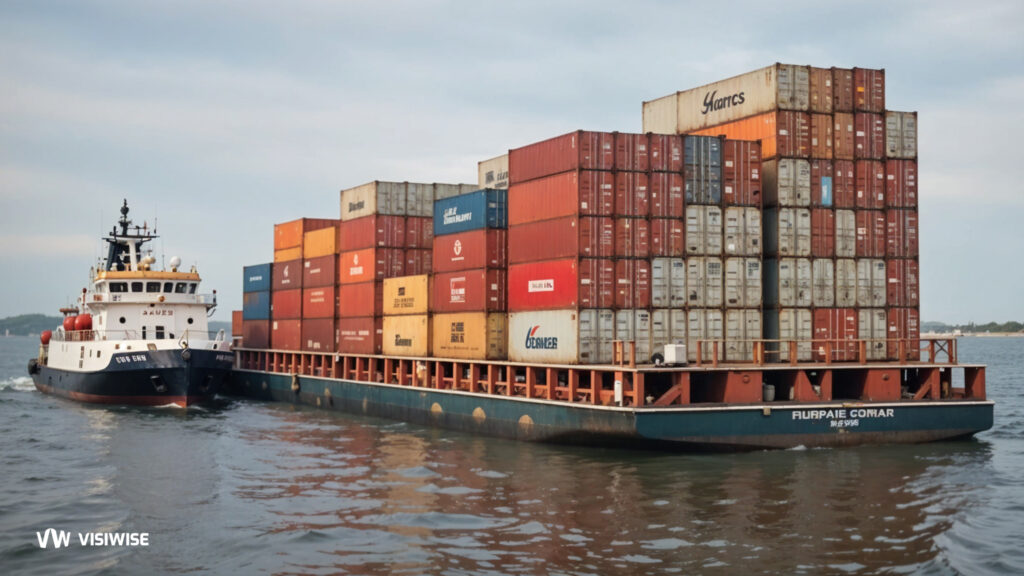In today’s global shipping market, having a reliable shipment visibility solution is crucial for staying ahead. Whether you’re navigating through disruptions or experiencing smooth operations, having real-time knowledge of your customers’ containers and freight locations empowers you to respond swiftly to inquiries and proactively address potential issues. In the past, freight forwarders relied solely on carriers and terminals for visibility information, which often came with errors and delays. However, the landscape has transformed with the rise of third-party visibility software. These innovative solutions have revolutionized the industry, offering accurate and timely data that helps optimize supply chain management. The advent of visibility platforms and container tracking APIs has revolutionized the way freight forwarders manage shipments and gain real-time insights into their supply chain. In fact, the "Freight Visibility" category has witnessed significant investments in recent years.
Companies now have access to advanced shipment visibility solutions known as Real-Time Transportation Visibility Platforms (RTTVPs). These innovative platforms, also referred to as visibility data providers, offer valuable insights into the status of shipments throughout the entire supply chain journey, from raw material procurement to production and final delivery. With these cutting-edge shipment visibility solutions, you can ensure seamless operations and deliver exceptional service to your customers. Gone are the days when it took weeks or even months for shippers to discover if their freight was damaged or lost due to incidents like containers going overboard or ships catching fire. With the help of third-party visibility providers, supply chain risks can be mitigated, and companies can make informed decisions in real-time. These solutions offer dynamic estimated time of arrival (ETA), automated exception detection, and proactive alerts, enabling businesses to stay on top of their operations. However, for freight forwarders to fully leverage this revolution within the logistics industry, it is essential to update orchestration and processes to align with the advancements in shipment visibility solutions. By embracing these innovative technologies, forwarders can optimize their operations and ensure seamless coordination throughout the supply chain. In this comprehensive guide, we will explore the key benefits of using visibility platforms and container tracking APIs, providing valuable tips and strategies for freight forwarders to optimize their operations and stay ahead in the competitive market. Furthermore, we will delve into the innovative solutions offered by Maher Terminal.
Understanding Shipment Visibility Solutions
Shipment visibility solutions, including visibility platforms and container tracking APIs, offer freight forwarders real-time visibility into their shipments. These digital tools enable seamless tracking of containers and provide accurate and timely information on their location, status, and estimated time of arrival. By leveraging advanced technologies such as IoT, GPS tracking, and cloud computing, freight forwarders can gain unprecedented visibility into their supply chain, enabling them to make informed decisions and improve overall operational efficiency.
Step Zero: Integrate Visibility with your TMS
We call it step zero because it’s so instrumental to using visibility data in all the other ways we recommend: integrate it directly into your transportation management system (TMS). This way, your team will have the most up to date information about all of your customers’ shipments. Once this essential integration is complete, you can leverage the data in three important ways: operationally, analytically, and for the benefit of your customers.
3 Uses of Real-Time Visibility Data for Forwarders
Once you have successfully integrated a shipment visibility solution and container tracking API into your Transportation Management System (TMS), you unlock a multitude of benefits that can significantly enhance your operations as a freight forwarder. Let’s explore the three main ways forwarders can leverage real-time visibility data to maximize efficiency and deliver exceptional service to their customers.
Operational Benefits
A) Streamlining Operations:
By integrating visibility data directly into your TMS or other native platforms, your team gains immediate access to specific details about the status of your customers’ shipments. This eliminates the need for manual data entry or relying on numerous emails and phone calls for tracking updates. Instead, the information you need is readily available and reliable, enabling your team to operate with improved accuracy and efficiency.
Operating efficiently as a freight forwarder is a delicate balancing act. Tracking shipments manually can be a cumbersome and time-consuming process that adds unnecessary stress to logistics management. However, with real-time visibility data seamlessly integrated into your systems, you gain a comprehensive overview of the action items that need to be completed before each load reaches its final destination. This includes knowing which shipments require customs clearance, which ones need delivery orders, and which customers need to be promptly updated on the latest shipment milestones.
Furthermore, unexpected events such as delays or disasters can disrupt your operations. By having visibility data integrated into your TMS, you can effectively perform exception management. You can compare the expected arrival date provided by the customer with the real-time tracking and visibility data and quickly identify shipments that deviate from the planned schedule. This allows you to take proactive measures, saving time, money, and building customer loyalty by promptly communicating any disruptions instead of waiting for an inquiry.
B) Proactive Decision-Making:
Real-time visibility data empowers forwarders to make informed decisions and take proactive actions throughout the transportation process. With accurate and up-to-date information at your fingertips, you can quickly identify bottlenecks, anticipate potential issues, and implement necessary adjustments to ensure smooth operations.
For example, if you notice a delay in a shipment’s progress through the visibility data, you can immediately take action to expedite the process, allocate additional resources, or communicate with relevant stakeholders to minimize any potential impact. This proactive approach helps you maintain control over your supply chain, optimize efficiency, and meet your customers’ delivery expectations.
C) Improved Customer Service:
Integrating visibility data into your TMS enables you to provide exceptional customer service by offering real-time updates and transparency to your clients. With access to accurate and reliable visibility information, you can keep your customers informed about their shipments’ whereabouts, estimated arrival times, and any unexpected events that may affect delivery.
By proactively sharing this information, you build trust and strengthen customer relationships. Your clients can plan their operations more effectively, adjust inventory management, and make informed decisions based on the real-time visibility data you provide. This level of transparency and collaboration fosters customer loyalty and positions your freight forwarding business as a trusted partner in their supply chain.
In a nutshell, integrating a shipment visibility solution and container tracking API into your TMS empowers you to optimize your operational efficiency, make proactive decisions, and deliver exceptional customer service. Real-time visibility data provides valuable insights that enable you to take prompt action, streamline your processes, and meet your customers’ expectations. By leveraging the power of real-time visibility, you can stay ahead in the dynamic world of freight forwarding and ensure the smooth and timely delivery of your customers’ goods from point A to point B.
Analytical Benefits
While shipment visibility solutions and container tracking APIs provide real-time information for supply chain professionals, they also offer valuable analytical capabilities. Analyzing past trends and data can provide insights into your company’s shipping habits and processes, allowing you to optimize your business and build stronger relationships with your customers as a freight forwarder. Let’s explore how leveraging visibility data for analysis can benefit your operations.
A) Understanding Shipping Habits and Processes:
Analyzing visibility data allows you to gain a comprehensive understanding of your freight operations. By examining data from the past week, month, or even year, you can identify patterns, trends, and areas for improvement. This analysis helps you optimize your processes, identify bottlenecks, and make data-driven decisions to enhance operational efficiency.
For example, by analyzing carrier performance data, you can identify which carriers consistently underperform and address any issues or consider alternative options. Understanding which interim ports your shipments move through enables you to optimize routing, reduce transit times, and minimize costs. Analyzing the carbon impact of your shipments helps you identify opportunities for sustainability initiatives and reduce your environmental footprint. By examining shipping lanes that experience frequent delays, you can proactively plan alternative routes or adjust schedules to mitigate delays and improve customer satisfaction.
B) Weather Analysis:
Visibility data often includes weather-related information during the shipment journey. By analyzing this data, you can identify correlations between weather conditions and shipping delays or disruptions. Understanding the impact of weather on your operations allows you to plan contingencies, allocate appropriate resources, and manage customer expectations.
For instance, if you notice a consistent pattern of delays during specific weather conditions, you can proactively inform your customers and adjust your operations accordingly. By leveraging historical weather data, you can anticipate potential disruptions and take preventive measures, such as adjusting shipping schedules or coordinating with carriers to ensure safe and timely deliveries.
C) Cost Optimization:
Visibility data provides insights into various cost factors associated with freight forwarding, such as demurrage spend. By analyzing demurrage data over time, you can identify trends and patterns that impact your costs. This analysis helps you optimize your operations to minimize demurrage charges, avoid unnecessary delays, and improve cost efficiency.
By understanding the factors contributing to demurrage fees, such as specific ports, carriers, or transit times, you can make informed decisions to reduce these costs. For example, you may choose alternative ports with lower demurrage charges or negotiate better terms with carriers based on historical data. By leveraging visibility data to optimize cost management, you can improve your profitability and provide competitive pricing to your customers.
By utilizing shipment visibility solutions and container tracking APIs for analysis provides valuable insights into your shipping habits, processes, and cost factors. By analyzing visibility data, you can optimize your operations, identify areas for improvement, and make data-driven decisions. Understanding carrier performance, shipping lanes, weather conditions, and cost factors empowers you to allocate resources efficiently, plan for contingencies, and enhance overall operational efficiency. By utilizing the analytical capabilities of visibility data, you can stay ahead in the dynamic freight forwarding industry and deliver exceptional service to your customers while optimizing your business for long-term success.
Customer-Facing Benefits
Establishing a loyal customer base and nurturing strong partnerships are crucial for long-term success in the freight forwarding industry. By leveraging shipment visibility solutions and container tracking APIs, you can provide valuable insights and real-time updates to your customers, earning their trust and fostering deeper relationships. Let’s explore how customer-facing benefits can be realized through visibility data.
A) Sharing Insights and Real-Time Updates:
Visibility data analysis often uncovers interesting findings and trends. By sharing these insights with your customers, you enable them to make better decisions and improve their planning. Whether it’s identifying factors contributing to shipment delays or highlighting areas for improvement, providing granular details and analysis helps both you and your customers address challenges and work together to avoid future disruptions.
Proactively reaching out to customers when delays occur showcases your commitment to transparency and customer service. By explaining the reasons behind delays and keeping customers informed, you build trust and demonstrate your proactive approach to problem-solving.
B) Integration into Customer Systems:
Taking customer-facing visibility to the next level involves integrating visibility data directly into your customers’ systems, positioning yourself as a strategic partner in their supply chain. Some effective integration options include:
Data Stream Integration
Establish a seamless data stream from your system to your customers’ Transportation Management System (TMS) or Enterprise Resource Planning (ERP) software. This integration allows customers to have the same real-time visibility as you do, enabling them to monitor all their shipments and streamline their operations.
Detailed Analytics Data
Share regular analytics reports or provide a periodic delivery of detailed analysis to your customers. This allows them to gain deeper insights into their shipping patterns, performance, and areas for improvement. Providing such valuable analytics data strengthens the partnership and demonstrates your commitment to helping customers optimize their supply chain.
Transactional Web Presence
Create a web interface where customers can track their shipments in real-time, similar to consumer package tracking. By providing a dot on the map and detailed status updates, customers can access the information they need without relying on email communication.
C) Customer Retention and Loyalty:
By creating direct integrations and granting visibility into your operations, you enhance the customer experience and increase the likelihood of long-term customer loyalty. When customers can easily access real-time status updates, track their shipments, and leverage detailed analytics, they feel empowered and engaged in the shipping process. This level of transparency and collaboration builds stronger customer relationships, making them more likely to choose your services repeatedly.
Furthermore, by integrating your visibility data into customer systems, you become an integral part of their supply chain operations. This deep integration streamlines processes, improves efficiency, and enhances overall customer satisfaction. By providing superior visibility and valuable insights, you position yourself as a trusted partner in their logistics journey, ensuring a customer for life.
leveraging shipment visibility solutions and container tracking APIs for customer-facing benefits is key to building strong customer relationships. By sharing insights, providing real-time updates, and integrating visibility data into customer systems, you earn trust, enhance transparency, and foster loyalty. Empowering your customers with the ability to track shipments, access detailed analytics, and make data-driven decisions strengthens the partnership and positions your freight forwarding business as a valuable asset in their supply chain.
Integrations to Operationalize Your Visibility Data
Despite the clear benefits of integrating visibility platforms, a significant number of supply chain functions still rely on outdated methods such as spreadsheets. This reliance often leads to inefficiencies and costly workarounds for data integration, as highlighted by McKinsey’s research indicating that 73% of supply chain functions still use spreadsheets.
To thrive in the coming decades, it is crucial to embrace the remarkable, innovative, and transformative data offered by third-party visibility platforms. Continuing to manually search for information on websites or relying on laborious data entry into Transportation Management Systems (TMS), or worse, resorting to spreadsheets, will hinder your ability to remain competitive.
Thankfully, integration projects no longer need to be daunting, time-consuming, or prohibitively expensive. With advancements in technology and the availability of user-friendly integration solutions, the path to achieving seamless visibility and data integration is within reach. By embracing these opportunities, you can unlock the full potential of your supply chain, improve operational efficiency, and position your business for success in the future.
Maher Terminal: Pioneering Innovations in the Industry
Freight forwarding is a critical aspect of the global supply chain, connecting manufacturers, suppliers, and end customers. To excel in this dynamic industry, freight forwarders require efficient tools and technologies that enable seamless shipment management. Maher Terminal, a renowned player in the maritime sector, offers innovative solutions that empower freight forwarders to streamline their operations and improve customer satisfaction. Two key elements of their comprehensive approach are the shipment visibility solution and the container tracking API, which provide invaluable capabilities to freight forwarders.
Maher Terminal offers a range of services to facilitate efficient and seamless operations in the maritime industry. Here are some of the key services provided by Maher Terminal:
Container Terminal Operations
Maher Terminal operates container terminals, providing handling and storage facilities for shipping containers. They ensure smooth operations, including loading and unloading of containers, container stacking, and storage management.
Vessel Operations
Maher Terminal manages vessel operations, including berthing and docking of ships, as well as coordinating the movement of containers between ships and the terminal.
Yard Management
Maher Terminal efficiently manages container yards, ensuring optimal utilization of space and effective organization of containers. This includes the positioning, tracking, and retrieval of containers within the yard.
Equipment Maintenance
Maher Terminal offers equipment maintenance services, ensuring that container handling equipment such as cranes, forklifts, and container handlers are well-maintained and in optimal working condition.
Terminal Operating System (TOS)
Maher Terminal provides a Terminal Operating System, which is a comprehensive software solution that helps manage and optimize terminal operations. This system includes functionalities such as container tracking, yard planning, and vessel scheduling.
Shipment Visibility Solutions
Maher Terminal offers shipment visibility solutions, providing real-time tracking and visibility of containers throughout the supply chain. This enables freight forwarders and other stakeholders to have up-to-date information on the status and location of their shipments.
Container Tracking API
Maher Terminal provides a container tracking API, allowing freight forwarders and other users to access real-time container data, including location, status, and estimated arrival times. This API can be integrated into existing systems, enabling seamless tracking and management of containers.
Customer Support
Maher Terminal offers dedicated customer support services, assisting clients with queries, providing guidance on terminal operations, and addressing any issues or concerns.
These services provided by Maher Terminal contribute to efficient and reliable container handling, facilitating smooth operations and enhancing the overall supply chain management process.
Benefits for Freight Forwarders
The container tracking API provided by Maher Terminal brings significant benefits to freight forwarders. Firstly, it automates the tracking process, eliminating the need for manual intervention and reducing the risk of errors. Real-time container tracking data, seamlessly integrated into existing systems, provides a holistic view of the supply chain, enabling efficient planning and execution. This integration also allows freight forwarders to proactively manage potential delays or disruptions, ensuring smooth and timely delivery of shipments.
Transparency and Trust
he availability of comprehensive container tracking data empowers freight forwarders to provide accurate and timely updates to their customers. This transparency fosters trust and confidence, enhancing overall customer satisfaction. By leveraging the shipment visibility solution and container tracking API, freight forwarders can offer a higher level of service and responsiveness, setting themselves apart from the competition.
Final Thought
As the world continues to progress and undergo constant change, Shipment Visibility Solutions and Container Tracking API have become essential tools for freight forwarders in the logistics industry. These solutions provide real-time insights, seamless integration, and proactive management, enabling freight forwarders to enhance customer satisfaction and operational efficiency. By leveraging these innovative solutions, freight forwarders can excel in the dynamic global supply chain and deliver exceptional service to their customers.



